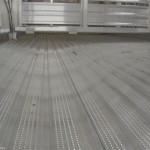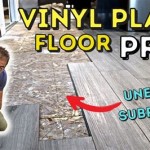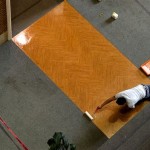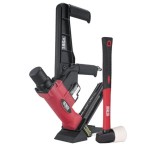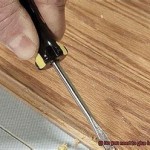Vintage Linoleum Flooring Rolls: A Durable and Stylish Retro Option
Vintage linoleum flooring rolls represent a significant period in interior design history. From its widespread use in the early to mid-20th century to its resurgence in popularity driven by retro aesthetics and sustainable material considerations, linoleum has proven its durability and adaptability. Understanding the characteristics, sourcing options, and maintenance requirements of vintage linoleum flooring rolls is crucial for anyone considering this classic flooring material.
Linoleum, derived from the Latin words "linum" (flax) and "oleum" (oil), is a resilient flooring material composed primarily of natural ingredients. These materials typically include linseed oil, rosin (pine resin), cork dust, wood flour, ground limestone, and pigments. This mixture is then calendared onto a jute or canvas backing. The resulting product is a durable, flexible, and naturally antimicrobial flooring option.
The appeal of vintage linoleum lies not only in its historical significance but also in its unique aesthetic qualities. Patterns range from simple, solid colors and geometric designs to intricate floral motifs and realistic simulations of other materials like marble or wood. These designs often reflect the prevailing styles of the era in which they were produced, offering a glimpse into the past and allowing homeowners to create authentic vintage-inspired interiors.
Identifying Authentic Vintage Linoleum
Distinguishing authentic vintage linoleum from modern reproductions or similar materials requires careful examination. Several key characteristics can aid in identification.
First, material composition is a critical factor. True vintage linoleum consists of the natural ingredients previously mentioned. Modern vinyl flooring, often mistaken for linoleum, is a synthetic product made from polyvinyl chloride (PVC). A visual inspection can sometimes be helpful; vintage linoleum often has a more matte finish compared to the glossier appearance of vinyl. Also, the edges of vintage linoleum, especially if exposed after cutting, will reveal the layered composition of the material.
Second, pattern characteristics can be indicative of age. Vintage linoleum patterns often feature specific color palettes and motifs characteristic of particular decades. Researching common designs from the 1930s, 1940s, 1950s, and 1960s can help narrow down the age of a potential flooring roll. For instance, Art Deco-inspired geometric patterns were prevalent in the 1930s, while atomic age designs characterized the 1950s.
Third, the backing material provides clues. Vintage linoleum typically features a jute or canvas backing. Examining the backing for signs of age, such as discoloration, brittleness, or the presence of jute fibers, can help confirm its vintage status. Modern reproductions often use synthetic backing materials.
Finally, consulting with antique dealers or flooring specialists with expertise in vintage materials can be beneficial. These professionals possess the knowledge and experience to accurately identify and assess the authenticity of vintage linoleum flooring rolls.
Sourcing Vintage Linoleum Flooring Rolls
Finding authentic vintage linoleum flooring rolls requires dedication and resourcefulness. Several avenues can be explored to locate these rare and desirable materials.
Architectural salvage yards are a primary source for reclaimed building materials, including vintage flooring. These yards often acquire materials from demolition sites or renovations, offering a chance to find original linoleum rolls that have been preserved over time. Careful inspection is necessary to assess the condition and quantity of the available material.
Antique stores and flea markets can also be promising hunting grounds. While not all antique stores specialize in architectural elements, some may carry salvaged flooring or rolls acquired from estate sales. Flea markets offer a more unpredictable environment, but diligent searching can sometimes yield unexpected discoveries.
Online marketplaces and auction sites provide a wider reach, allowing potential buyers to search for vintage linoleum from various locations. However, online purchases require extra caution. Thoroughly reviewing product descriptions, examining photographs carefully, and communicating with the seller to ask specific questions about the material's condition and authenticity are crucial steps.
Estate sales and auctions represent another potential source. These events often offer a glimpse into homes from previous generations, where original linoleum flooring may still be present. Attending estate sales in older neighborhoods or areas known for their historic architecture can increase the likelihood of finding vintage linoleum.
When sourcing vintage linoleum, it is essential to consider the condition of the material. Look for rolls that are relatively intact, with minimal damage such as cracks, tears, or discoloration. Assess the amount of usable material available and factor in the cost of cleaning, repair, and installation.
Caring for and Maintaining Vintage Linoleum
Proper care and maintenance are essential to preserving the beauty and longevity of vintage linoleum flooring. While durable, linoleum is susceptible to damage from improper cleaning methods and neglect.
Regular cleaning should involve sweeping or vacuuming to remove loose dirt and debris. Avoid using harsh chemicals or abrasive cleaners, as these can damage the surface of the linoleum and fade the colors. Instead, opt for a mild detergent or a pH-neutral cleaner specifically designed for linoleum floors.
Damp mopping with a soft mop is an effective way to clean linoleum. Be sure to wring out the mop thoroughly to prevent excess water from seeping into the seams or under the edges of the flooring. Excess moisture can lead to warping or mildew growth.
To protect vintage linoleum from scratches and scuffs, use felt pads under furniture legs and avoid dragging heavy objects across the floor. Area rugs can also provide an additional layer of protection in high-traffic areas.
Applying a linoleum-specific floor wax or polish can help protect the surface and enhance its shine. Following the manufacturer's instructions for application and maintenance is crucial. Regular waxing can help prevent staining and make the floor easier to clean.
Addressing stains promptly is important to prevent them from becoming permanent. Blot up spills immediately with a clean cloth. For stubborn stains, try using a paste of baking soda and water or a mild solution of vinegar and water. Always test any cleaning solution in an inconspicuous area first to ensure it does not damage the linoleum.
Sunlight can cause fading of vintage linoleum over time. Consider using curtains or blinds to protect the flooring from direct sunlight exposure, especially in rooms with large windows.
If significant damage occurs, such as cracks or tears, professional repair may be necessary. A flooring specialist with experience in vintage materials can assess the damage and recommend appropriate repair techniques. In some cases, it may be possible to patch or replace damaged sections of linoleum with matching vintage materials.
Restoring vintage linoleum can be a worthwhile endeavor for those seeking an authentic retro look. The process may involve stripping old layers of wax or polish, repairing minor damage, and applying a new sealant or finish. While restoration can be labor-intensive, the results can be stunning, bringing back the original luster and beauty of the flooring.
In conclusion, vintage linoleum flooring rolls offer a unique blend of durability, style, and historical significance. By understanding the characteristics of authentic vintage linoleum, exploring various sourcing options, and implementing proper care and maintenance practices, homeowners can preserve and enjoy this classic flooring material for generations to come.

Linoleum Archives Warehouse Direct Flooring
That 70s Floor The Designers Behind A Familiar Vintage Kitchen Pattern 99 Invisible

Retro Fl 2 Sheet Vinyl Flooring 3 Metre Wide Roll 118

Dollhouse 1 12 Green Retro Linoleum 70 S Kitchen Vinyl Flooring Vintage Floor Tiles Printable Sheet For Roombox

Vintage Vinyl Floorcloth Rug Pattern 33 I Am Not A Bumblebee Hudson Vine

Get Down With 70 Groovy Vintage Vinyl Floors From The 70s 80s Americana

Get Down With 70 Groovy Vintage Vinyl Floors From The 70s 80s Americana

Patterned 1970s Style Vinyl Flooring From Armstrong Cork And Linoleum Looks Too Retro Renovation

Vinyl Flooring Vintage Lino Black White Mosaic Tiles Chequerboard Chess Board

Moor Vinyl Pvc Flooring Linoleum Azulejos Floor Decor Diy 26tl


